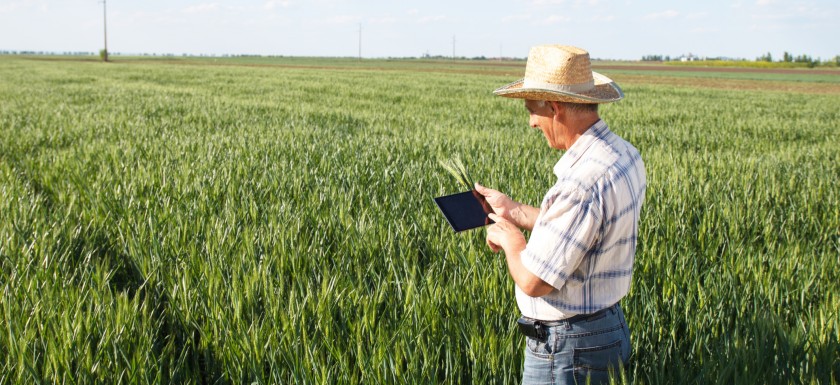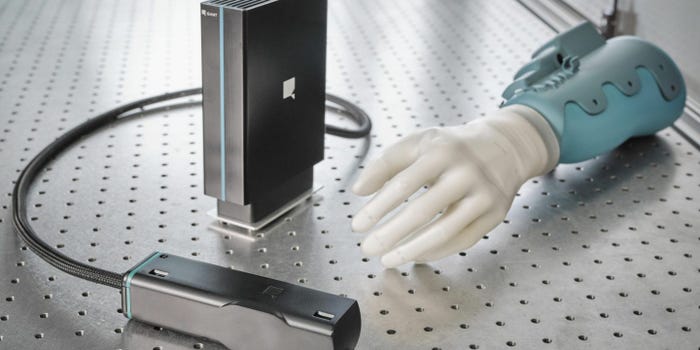Corn Belt farmers and Silicon Valley engineers are converging as mobile apps and IoT technologies for agriculture proliferate.
May 20, 2016

In Germany, a farmer drives his tractor and works the land like generations before him. The tractor is equipped with an iPad docking station. There’s a smartphone in his pocket. On the seat lies a 400-page book of DuPont’s product info for keeping insects, crop diseases and weeds at bay.
Why isn’t a sleek, mobile app providing crop-protection content instead of a heavy, outdated book?
DuPont spent 12 weeks creating a mobile app and converting the book’s voluminous pages into HTML files. Now when a new crop gets registered on a product label, the German farmer has the right information at his fingertips when applying crop-protection products in the field.
The mobile app is also designed specifically for the farmer. “It’s got really big buttons, because many farmers have big hands,” says Joanne Hewitson, global digital marketing lead at DuPont Crop Protection.
This is just the beginning of DuPont’s efforts to put the power of mobile into the big hands of farmers around the world. Millions of farmers in dozens of countries can expect a mobile app like the one in Germany in the next few months, from Australian farmers plowing large acreages to Chinese farmers tending to lots no bigger than the lawn of a typical American home.
American farmers, too, will get their first DuPont mobile app tailored to them later this year, Hewitson says.
Farmers trade pitchforks for tablets
Most people outside the farming industry think of Corn Belt farmers and Silicon Valley engineers as polar opposites, but they’re wrong. Farmers are proven pioneers of technology, adopting everything from driverless tractors to Internet of Things to mobile apps. Nearly three out of four field crop farmers with more than $250,000 in gross sales have smartphones, while more than half have tablets, according to an Ipsos survey last year.
The field of mobile apps has hundreds of apps covering all sorts of farming functions: commodity pricing, equipment pricing, farm management, soil sampling, product labels, tank mixing, yield prediction, nutrient removal, crop planning, grain shrinkage, performance tracking, equipment service, weed/pest management, field mapping, weather, fertilizer and spray planning, etc.
Brian Arnall, Ph.D., an associate professor and precision nutrient management extension specialist at Oklahoma State University, as well as a farmer, has an iPad with 275 free farming apps (not including livestock apps), albeit mostly for testing and research purposes. “It’s a lot more crowded than a year ago at this time,” he says.
Farmers aren’t office dwellers, and so they depend on mobile devices throughout the day. A recent agriculture survey from Penton, which publishes Five2ndWindow, found that more than half of farmers regularly check mobile devices for farm-related news. The top five mobile activities are weather, news, market data, search and navigation (see chart below). Nine out of 10 farmers also showed interest in localized agricultural information.
“It’s really been in the last two years that mobile has taken off, and now it’s commonplace technology for farmers,” Hewitson says. “The pitchfork is gone.”
Arnall, too, has seen huge adoption of mobile apps. Farmers, including himself, have been using high-end electronics for years and today rely on a half-dozen mobile apps daily. They often turn their smartphones into hot spots so that Wi-Fi tablets can stay connected, he says. Hewitson knows of an Indiana farmer who strategically placed hotspots around his farm so that he always has access.
So will farmers flock to the DuPont app? Or will the app add to the clutter? Arnall thinks there will be at least some initial interest. “If you have something DuPont specific, that would be handy,” he says. “More players providing valuable and timely information to producers is a good thing.”
Growing a mobile app takes patience
DuPont’s mobile app in the United States will initially offer crop-protection content in the form of searchable product info, how-to tutorials, testimonials and perhaps video, essentially replacing printed material. The content will be stored on the mobile device itself and accessible offline—a key differentiator between a mobile app and a mobile website.
Strawberry farmer checks quality of crop with tablet
“>
Strawberry farmer checks crop quality with tablet
Getting the content into the mobile app sounds easy, but it’s still a feat. The data has to be localized to every country, regional crops, pests and regulations. Changes to content have to be automatically updated wherever they apply. It’s a big deal. Crop-protection content is critical to a farm’s success: 20 to 40 percent of potential food production is lost every year to insects, crop diseases and weeds.
On the upside, DuPont no longer has to publish a 400-page book of product labels and safety data sheets. Hewitson says this savings alone provides enough return on investment to justify the mobile app, with an estimated $1 million in savings from reduced printing and $500,000 in efficiency savings from using a single platform, in this case, Adobe Experience Manager Mobile. DuPont also hopes to gain insight from the mobile data, such as which assets are most popular.
It’s important to note mobile ROI, because most marketers struggle to demonstrate returns on their mobile marketing efforts, research firm Forrester says.
“Only 27 percent of marketers surveyed told us the ROI on their mobile marketing campaigns was profitable, and a stunning 67 percent told us they simply cannot measure it,” say Forrester analysts Jennifer Wise and Thomas Husson, in a report. “Consequently, it comes as no surprise that only 20 percent of marketers have the budget they need for mobile initiatives today.”
Related: How Delighting Customers Becomes a Profit-Boosting Strategy
Forrester’s findings extend beyond a mobile app, but the point is clear: Mobile app development is slowed in part by budget. Metrics for measuring engagement can also be elusive. Then there’s the sheer number of mobile apps vying for a farmer’s attention, such as MFA Agronomy Guide, AgLogic Mobile, FieldX Sampling, iSoyl, Farm At Hand, OpenScout, Connected Farm Field, to name a few.
“Farmers do a lot of different things, not just crop protection, and so there’s a lot of options out there on what apps, what tools,” Hewitson says. “Creating something that is useful and different is probably the toughest thing.”
Reaping the power of mobile
A digital alternative to a printed book isn’t exactly innovative, and so DuPont will have to bring more features to its mobile app. Globally, DuPont has more than a dozen apps that offer a single function, such as a rebate calculator tool and a pest-identification tool, which are available on Apple App Store and Google Play (although not customized to the American farmer). In Europe, DuPont’s pest-identification tool taps a database of weed photos and has a messaging feature to connect a farmer with an agri-expert.
After launching the mobile app for American farmers, DuPont’s next step will be to get these legacy tools and features, perhaps messaging and push notification, into the app. Hewitson expects this to happen sometime next year.
“IT’S REALLY BEEN IN THE LAST TWO YEARS THAT MOBILE HAS TAKEN OFF, AND NOW IT’S COMMONPLACE TECHNOLOGY FOR FARMERS. THE PITCHFORK IS GONE.” – JOANNE HEWITSON, DUPONT CROP PROTECTION
Further out, the big idea is to have a mobile app personalized to the individual farmer; mobile personalization is considered the holy grail of the customer experience. But it’s tricky. Push too far or too fast toward personalization, and you risk alienating customers concerned about their privacy.
“There’s an opportunity to make missteps, particularly with geo-location and personalization,” Hewitson says. “You want the customer experience to be right the first time. The risk of losing that relationship is too high.”
Related: Earn Customer Trust, Avoid Betrayal
When it comes to privacy concerns, Arnall sees a mixed bag among farmers. Conventional wisdom says older farmers care more about privacy than younger ones, but that’s not the case, he says. Many farmers of all ages see the value of personalization, while others remain skeptical.
Arnall has yet to see a “killer” farming app, or even an app that “wows” him. Most apps offer a single function, but farmers want a single app that does it all. Such an app, though, would be too expensive for the average farmer, Arnall says.
Internet of Things and the farmer
One potential feature with a built-in “wow” factor might be the convergence of two tech forces: mobile and Internet of Things. With the latter, DuPont has a “smart” herbicide dispensing system in the shape of a big refrigerator that creates a herbicide blend depending on a farmer’s weed spectrum, length of control and acreage.
“There’s a cool possibility to build in some of that connectivity between mobile apps and IoT to give farmers easy record keeping and data to run their farms more efficiently,” Hewitson says.
Arnall agrees: “It’s a very neat concept. If they can get that out there, there will be others scrambling to do the same in the very near future.”
penton agriculture
“>
Such a marriage is still a ways off, Hewitson concedes. DuPont isn’t alone when it comes to wading carefully into mobile. The story of mobile today is about great expectations undermined by a hard-scrabble reality. While mobile has a lot to offer, such as geo-location, only one out of three companies uses location to make mobile services more relevant to customers, Forrester says.
Nevertheless, the farming industry, given its history of tech adoption, is fertile ground for the next evolution of mobile.
“I come from a farm—my family farms—and when I talk to my dad about some of these tools, it really changes the way farmers get information and do their jobs,” Hewitson says.
Five Mobile App Takeaways
Fertile Ground: If you think your customers aren’t savvy about mobile apps, think again. Mobile is the new normal.
Field of Apps: Don’t be discouraged by a market already full of mobile apps. Make sure your app delivers something easy and useful to entice adoption.
Low-hanging fruit: Start with content. Then wade into personalization and geo-location carefully, since privacy concerns can turn off customers.
Testing Bed: Identify and test your mobile app in smaller markets before rolling it out to larger markets.
Cultivating: Mobile projects can sour because of a perceived lack of return on investment. Find operational cost savings in initial mobile projects to fund other mobile projects.
Article originally appeared on Five2ndWindow
About the Author(s)
You May Also Like


.png?width=700&auto=webp&quality=80&disable=upscale)
.png?width=300&auto=webp&quality=80&disable=upscale)


.png?width=300&auto=webp&quality=80&disable=upscale)